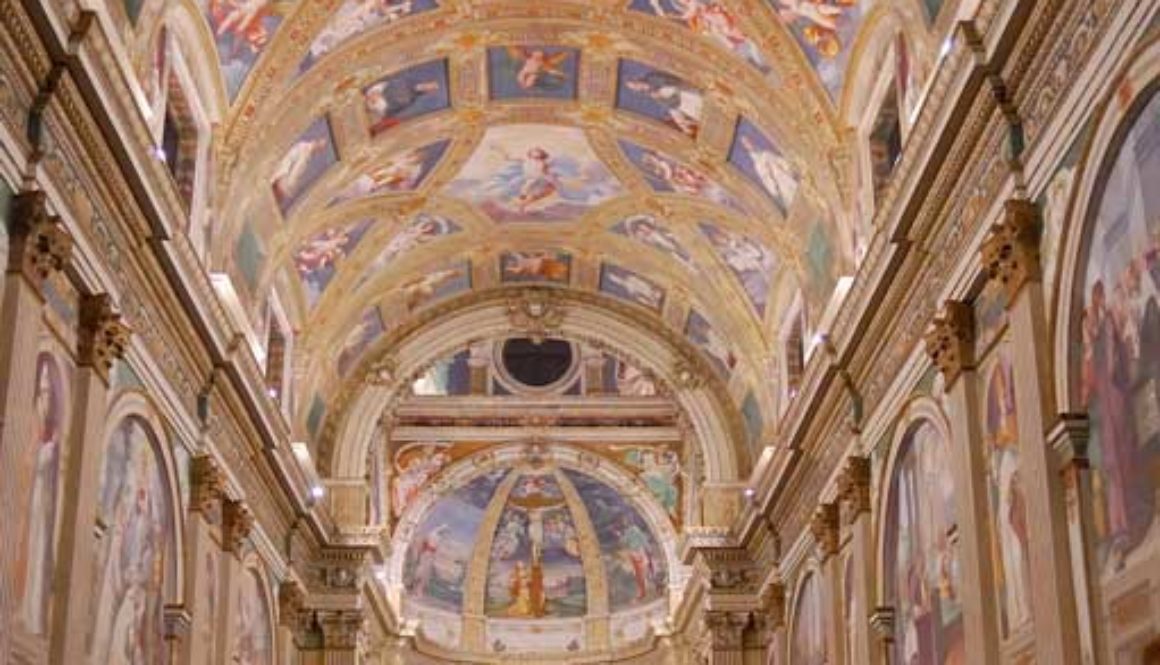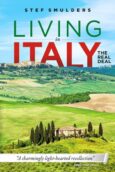Downtown Abbey in Milan
Milan is a city rich in churches, abbeys and religious and holy places. As the hometown of one of the Church Fathers, Saint Ambrose, it could not have been otherwise. The Duomo of Milan may be its most famous attraction but the capital of Lombardy has more to offer. A special attention deserve the abbeys founded by the different religious orders over the centuries. As the monks wanted to live in separation from the material world, most of the places are a bit further out of the center. Let us present them.
Monasteries and abbeys of Milan
- Certosa di Garegnano
 A bit further out of city center, in a straight line north-west from the Arco della Pace , lies this monastery of the Carthusian order. The monastery was originally founded in the 14th century by the Visconti , but the church is about all that remains today. It has some later additions, like the 18th century facade shows. The main reason to visit the church are the Renaissance frescoes and paintings of Crespi (depicting the story of San Bruno , founder of the Carthusian order), of Caravaggio ‘s teacher Peterzano (Nativity, The Adoration of the Magi, Resurrection, Madonna with the Child and Saints and the Ascension) and of Zenale ( San Michele )
A bit further out of city center, in a straight line north-west from the Arco della Pace , lies this monastery of the Carthusian order. The monastery was originally founded in the 14th century by the Visconti , but the church is about all that remains today. It has some later additions, like the 18th century facade shows. The main reason to visit the church are the Renaissance frescoes and paintings of Crespi (depicting the story of San Bruno , founder of the Carthusian order), of Caravaggio ‘s teacher Peterzano (Nativity, The Adoration of the Magi, Resurrection, Madonna with the Child and Saints and the Ascension) and of Zenale ( San Michele ) - Chiaravalle Abbey
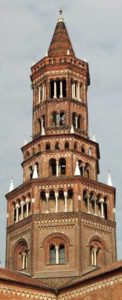 This abbey was founded (12th century) by St Bernard of Clairvaux as part of a chain of Carthusian abbeys all over Europe. Culture and spirituality can be sensed here , where you tread on truly historical ground . The abbey is located a few km outside of Milan, in the hamlet properly named after its founder, Chiaravalle . Worth seeing are the tower, in fired brick and Candoglia marble; the roman central door with wings sculptured in relief; the cloisters , with columns and capitals that portray men and animals; the 14th century paintings; the 16th/17th century frescoes by Luini and others and the 17th century portico. There are also engravings at the entrance to the chapter, east of the cloister, attributed to Bramante , that display a view of Milan as it was at the time: the Filarete tower of the castle, the Duomo without the statues, the Santa Maria delle Grazie (of the Last Supper) still under construction. The nickname of the tower, ciribiciaccola in Milanese dialect was used in a famous tongue-twister nursery rhyme:
This abbey was founded (12th century) by St Bernard of Clairvaux as part of a chain of Carthusian abbeys all over Europe. Culture and spirituality can be sensed here , where you tread on truly historical ground . The abbey is located a few km outside of Milan, in the hamlet properly named after its founder, Chiaravalle . Worth seeing are the tower, in fired brick and Candoglia marble; the roman central door with wings sculptured in relief; the cloisters , with columns and capitals that portray men and animals; the 14th century paintings; the 16th/17th century frescoes by Luini and others and the 17th century portico. There are also engravings at the entrance to the chapter, east of the cloister, attributed to Bramante , that display a view of Milan as it was at the time: the Filarete tower of the castle, the Duomo without the statues, the Santa Maria delle Grazie (of the Last Supper) still under construction. The nickname of the tower, ciribiciaccola in Milanese dialect was used in a famous tongue-twister nursery rhyme:
Sul ponte di Chiaravalle
Si vede una torre chiamata ciribiciaccola,
con cinquecento ciribiciaccolini.
Vale di più una ciribiciaccola
o cinquecento ciribiciaccolini? - Mirasole Abbey
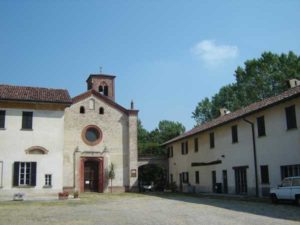 This abbey is one of the best preserved examples of a medieval farmhouse courtyard . Originally it was inhabited by the Umiliati order, that consisted of priests and laymen. They worked in the field and dedicated themselves to the production of wool. The buildings were surrounded by a ditch and defended by a tower originally fitted with a draw-bridge. Two entrances , one from the city, the other one from the fields, led into the courtyard surrounded by stables, houses and workshops. Alongside the courtyard there is the cloister , with refectory, kitchens, capitular room and sacristy, and porticoes on four sides on the ground floor, on two sides on the first floor . There is also a loggia which acted as a dormitory and granary. The 14/15th century church is dedicated to St. Mary. The frescoes in the apse have been attributed to the Lombard Renaissance school, and they depict the Four Evangelists, the Assumption of the Virgin, and a portrait of the prior who commissioned the work.
This abbey is one of the best preserved examples of a medieval farmhouse courtyard . Originally it was inhabited by the Umiliati order, that consisted of priests and laymen. They worked in the field and dedicated themselves to the production of wool. The buildings were surrounded by a ditch and defended by a tower originally fitted with a draw-bridge. Two entrances , one from the city, the other one from the fields, led into the courtyard surrounded by stables, houses and workshops. Alongside the courtyard there is the cloister , with refectory, kitchens, capitular room and sacristy, and porticoes on four sides on the ground floor, on two sides on the first floor . There is also a loggia which acted as a dormitory and granary. The 14/15th century church is dedicated to St. Mary. The frescoes in the apse have been attributed to the Lombard Renaissance school, and they depict the Four Evangelists, the Assumption of the Virgin, and a portrait of the prior who commissioned the work. - Viboldone Abbey
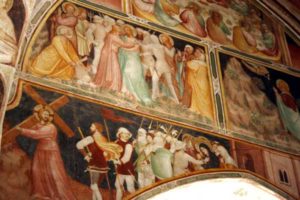 If you’re in for a little trip to the Milanese countryside , then the Viboldone Abbey would be a nice suggestion. After taking the train, bus or metro you’ll still have to walk for about a km before reaching the abbey. The abbey was founded by the Umiliati order in the 12th century and the building was only finished in the 14th. Of the original monastery itself hardly anything remains. The one reason to make the trip worthwhile is the presence of many splendid 14th century frescoes clearly influenced by Giotto . Don’t forget to look for the wooden crucifix.
If you’re in for a little trip to the Milanese countryside , then the Viboldone Abbey would be a nice suggestion. After taking the train, bus or metro you’ll still have to walk for about a km before reaching the abbey. The abbey was founded by the Umiliati order in the 12th century and the building was only finished in the 14th. Of the original monastery itself hardly anything remains. The one reason to make the trip worthwhile is the presence of many splendid 14th century frescoes clearly influenced by Giotto . Don’t forget to look for the wooden crucifix. - Morimondo Abbey (Vigevano)
A bit out of the city of Vigevano , near the Ticino river, lies the 12th century monastery and basilica of Morimondo . The name originates from the Cistercian founding fathers, who came from the French abbey of Morimond . It is mainly the basilica that is worth a visit, being a fine example of the grandiose and solemn architectural style of the churches initiated by St Bernard, although the church of Morimondo has undergone several changes during the ages. Inside, the most valuable elements are the wooden choir , with 70 walnut inlaid stalls; the 14th century holy water font at the first pillar; the Madonna with Child and the Saints fresco by Bernardino Luini. There is a museum inside the cloister, which can only be visited after reservation (3 euro). After visiting the abbey you may want to try the Trattoria Coronata di Morimondo for an excellent lunch or dinner! A nice way to visit the abbey is offered by the Autostradale company in the form of a guided tour on Sundays in May, June and July, that starts off with a boat trip on the Navigli in Milan, followed by a bus trip to the abbey. A lunch at Morimondo is included. The trip leaves at the Castello at 9am and costs 49€, lunch at 9€ or 14€. - San Sigismondo Abbey (Cremona)
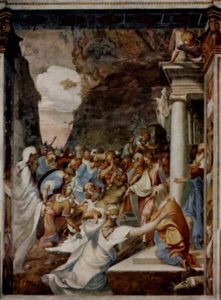 This 15th century church, commissioned by Bianca Maria Visconti to celebrate her wedding with Francesco Sforza , is the only major sight of Cremona that is located rather far out of the city center (2 km south east, on the road towards the hospital). The first stone that was laid for the church can still be seen behind the main altar, with the text: ” Here Francesco Sforza, Duke of Milan, joined in marriage Biancamaria daughter of Filippo Visconti … in the year 1447 “. The marriage also signified the union between the two rival families. The church is especially worth visiting for its rich collection of Renaissance paintings and frescoes by Boccaccino (Eternal Glory of Christ, Resurrection of Lazarus, Christ and the adulteress) and several members of the Campi family: Madonna with Child, Saints Daria, Sigismondo, Girolamo and Crisante with Francesco Sforza and Bianca Maria Visconti , Pentecost, Saints Cecilia and Catherine, Beheading of John the Baptist and Glory of Paradise are some of the works to be admired. Also look for the organ , which in part is the Renaissance original with artwork of Campi and Pesenti . The feast after the wedding of Francesco and Bianca Maria lasted for days and included a banquet at which a large type of cake in the form of the Torrazzo tower was presented, probably the first torrone of Cremona. The feast is re-enacted each year at the Torrone Festival in November.
This 15th century church, commissioned by Bianca Maria Visconti to celebrate her wedding with Francesco Sforza , is the only major sight of Cremona that is located rather far out of the city center (2 km south east, on the road towards the hospital). The first stone that was laid for the church can still be seen behind the main altar, with the text: ” Here Francesco Sforza, Duke of Milan, joined in marriage Biancamaria daughter of Filippo Visconti … in the year 1447 “. The marriage also signified the union between the two rival families. The church is especially worth visiting for its rich collection of Renaissance paintings and frescoes by Boccaccino (Eternal Glory of Christ, Resurrection of Lazarus, Christ and the adulteress) and several members of the Campi family: Madonna with Child, Saints Daria, Sigismondo, Girolamo and Crisante with Francesco Sforza and Bianca Maria Visconti , Pentecost, Saints Cecilia and Catherine, Beheading of John the Baptist and Glory of Paradise are some of the works to be admired. Also look for the organ , which in part is the Renaissance original with artwork of Campi and Pesenti . The feast after the wedding of Francesco and Bianca Maria lasted for days and included a banquet at which a large type of cake in the form of the Torrazzo tower was presented, probably the first torrone of Cremona. The feast is re-enacted each year at the Torrone Festival in November. - Certosa di Pavia
See the other post in this blog.
